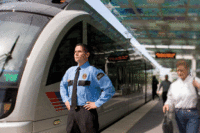Safe Ride

One of the employees you’ll see on the grounds of Utah’s Lagoon Park nearly every day of the year is Jon Wright, telecommunications administrator for the park. Wright has the responsibility of providing video surveillance for all of the park’s main attractions, gaming areas, entertainment venues, eateries, parking lots, gates and admissions areas – just about everywhere on the massive site.
When Wright started at Lagoon Park approximately 10 years ago, the video system was outdated by modern standards. To take advantage of the wiring infrastructure available throughout the park, Wright designed and implemented a video surveillance system that employed what was truly defined as video security technology.
In essence, Wright wired video cameras throughout the facility in the same method as a cable television system, where each camera signal was modulated and viewed by channel designation at various locations throughout the facility. However, in a few short years, it became apparent that the system set-up was not adequate to handle the extra volume of cameras needed to provide adequate coverage of the park – there were simply not enough channels available on the system for each camera. Camera control, switching and recording were also significant issues to be addressed.
“What we originally had was basically a cable TV system,” says Wright. “All the cameras were connected to a modulator, and all the signals were sent down one coax cable to our head-end, where everything was demodulated for viewing on standard televisions. To view different cameras, you just had to change the channel like you would if you were watching cable TV at home.
“That worked-out fine until we had so many cameras that there were not enough channels to allocate,” adds Wright. “We were up to 130 cameras with four racks full of modulators, so we needed to find a new solution.”
As Lagoon Park continued to grow, so did the facility’s need for expanded camera coverage. In addition to providing security for park attendees and employees alike, Lagoon Park’s management teams wanted the ability to closely monitor employees and visitors on rides, eating facilities, areas where cash and tickets were handled and pedestrian traffic throughout the park. To accomplish this goal, Wright needed to greatly expand the number of cameras deployed throughout the park, while providing viewing capabilities to some 40 remote locations, many of which required the ability to control cameras.
After thoroughly researching his options and devising a unique plan to integrate the modulated cameras into a matrix-switching environment, Wright called upon TV Specialists Inc., a local professional video dealer that specializes in security systems products. He also turned to Richard Miller from RPM Associates, Inc., Panasonic Security Systems, a sales representative for advice and product recommendations.
Wright’s system concept involved integrating the modulated cameras with the Matrix 850 from Panasonic, Secaucus, N.J., a powerful matrix switching system that affords both programming versatility and multi-user operation along with tremendous camera capacity. He could then add additional cameras on the same coax loop needed to achieve the additional coverage for which he had planned. The Matrix 850’s RS485 protocol input seemed to be the key to the success of the integration scheme, but it had never been done before, so the system would be untested on a large scale until it was actually installed.
The Panasonic Matrix System 850 also provided the Wright with the capability to install up to 64 satellite systems with control capabilities. This provided him with the capability to provide monitoring and control capabilities for any camera in the system from satellite locations. In addition, when fully configured, the system 850 can accommodate approximately 9,000 cameras, 1,024 monitors and 128 system controllers making it ideal for large installations such as Lagoon Park. The system provides advanced switching capabilities that allow cameras to be switched automatically in “tour” or “group” sequences that are programmable through the system administration console. In addition, “events” can be programmed by time/date or alarm activation to provide automated camera PTZ movement with preset switching, recording and monitoring sequences.
“The reason we stuck with using all the camera modulators is because the park is over a hundred years old and we did not have the luxury of installing new cable plants from the ground up. We basically had to use what we had at our disposal, which meant modulating everything on the existing coax,” Wright says.
The demodulators at the head-end receive the modulated camera’s video signals and convert them to NTSC video. The Panasonic system recognizes the camera signals separately, which provides the signals needed for switching, recording and control functions,” Wright says.
"That's the beauty of this system," Wright says. "It's incredible what we can control using the RS485 capability. It is far more versatile than I thought it would be."
Wright says that having the ability to control all the cameras "was a dream" because typically, control was over one coax, which does not have that flexibility.
"When I found out that I could use RS485, it just totally opened up the system," he says. "I just disconnected the wires from the old system, plugged in the wires to the new Panasonic system, and everything worked fine.
In addition to viewing locations at the systems head-end, there are also approximately 40 satellite locations throughout Lagoon Park that are monitored with the system. Panasonic matrix controllers are located in 16 locations, providing various management personnel, including executive management, with priority level access to view and control various cameras in the system. The controllers are connected to the Matrix system via Ethernet connection on the park’s local area network (LAN).
The remaining viewing locations still utilize the modulated “cable TV” system to view and access different cameras individually. The cameras are modulated in groups so that a certain management office has access to the specific cameras watching their areas of interest only. If a manager needs to view a camera from another area, he can call security and have the specific camera modulated to his viewing system. This provides a great deal of versatility as Lagoon Park continues to expand and upgrade attractions every year.
“Every manager has a monitor in their office with a Panasonic controller," Wright says. "Managers can watch the rides they’re responsible for and monitor personnel activity, see that the rides are operating smoothly and make sure the waiting lines are flowing smoothly. The foods division monitors service areas and food stations to help assure that people are being serviced courteously and quickly, and that tables are clean.” The system can zoom in on the tables, on the floors, on the soda fountains so you can see that everything is clean as it should be, he says.
Other uses of the new system include:
• viewing traffic flow into parking lots to be sure vehicles are not backing up onto the freeway
• monitoring maintenance personnel throughout the park to spot problems requiring attention
• monitoring the park's electrical power-generating facility by zooming it on and oil switches
Lagoon Park maintains diligent security over the park 24-hours a day, Wright says. Security personnel have full access to view and control any camera in the system with override capabilities. The central control room is compact and smartly configured for viewing and controlling multiple cameras. Aided by security personnel stationed throughout the park – both uniformed and undercover – the security staff is able to keep its finger on the pulse of all the action in the park.
In addition, all of the interior camera sites include audio monitoring equipment, so security and management personnel can listen to conversations between park employees and visitors to monitor quality of service and responsiveness.
The security system at Lagoon Park employs several hundred Panasonic video surveillance cameras, including a substantial number of high performance WV-CS854A and WV-CS654 unitized cameras with Panasonic’s Super Dynamic II technology.
The WV-CS854A camera is an advanced dome camera system providing a dynamic range 64 times greater than conventional video cameras to provide high quality images even under severely contrasted lighting conditions. The unit also features day/night operation, which the cameras automatically switch from color to black-and-white to provide the best possible images in the available light. The combination of these features assures that Wright captures the highest quality images available in any lighting conditions at any time. Eventually, Lagoon Park plans to switch over all of its cameras to the WV-CS854A unitized cameras according to Wright.
At Lagoon Park, you’ll see Panasonic video surveillance shows up in some of the oddest places.
Wright’s favorite vantage points for cameras are atop the highest attractions. Towering 173 feet above the park and virtually everything else in the Salt Lake area is Skycoaster – where patrons “fly” through the air some 143 feet off the ground suspended by flight cables.
The Panasonic Super Dynamic II camera mounted on the Skycoaster provides a clear view of the park and all the highways leading to it. Outfitted with a powerful zoom lens and rugged pan/tilt housing, the camera can be positioned and focused to spot a coin on the park floor, or view traffic miles away down the highway.
“We can watch traffic flow and can quickly determine if we need to get more ticket takers at the auto gates where cars come in for parking,” Wright says.
“Maintaining cameras, which primarily entails cleaning the housings, can be challenging,” he says. “To reach the camera on top of the Skycoaster, one of our guys needs to climb up the arch wearing a safety harness. The camera is offset from the arch so it can look down on the ride without the structure being in the way, which makes it a little difficult to reach. You have to just lean over and work on it. Its really easy to maintain though, because the doors on the unit fold open for easy access.”
Cameras also are mounted in Lagoon Park’s Music Theatre. Like the majority of the cameras in the system, the units can be controlled remotely. This allows Wright to send video and audio feeds of live performances to other viewing areas within the park. The cameras also are used to supply footage to the media by simply tying into Panasonic's Matrix System 850 at the system's head-end.
Wright records video and audio signals from the park’s extensive video surveillance system on Panasonic WJ-HD500 digital video recorders. The majority of the recording equipment records high-resolution images of all activities in those areas where cash transactions take place.
With 720 x 480 pixels – over 500 lines of horizontal resolution – the WJ-HD500 captures fine recording details. The units feature 160GB of on-board storage capacity that can expand to up to 2 terabytes with three optional hard disk expansion units. Three different DVD recording solutions also are available for archiving recorded footage. Panasonic’s DVD-RAM solution is also the first archiving system that allows direct playback without dubbing from the archived media back to the hard drive.
The WJ-HD500’s triplex feature allows simultaneous live monitoring, recording and reproduction. Layered recording allows individual camera recording and recovery from motion detection, activity detection or hard-contact alarm inputs. The WJ-HD500 also features on-board networking and motion detection capabilities as standard features for advanced systems integration. No additional software except a Web browser is required to view live and recorded images on a PC from a remote site.
SIDEBAR 1: Behind the Scenes
With a history that dates back to 1886, Lagoon Park has proven to be a highly popular recreational spot for residents of the Salt Lake area in Utah. Located in a suburban area just 17 miles north of Salt Lake City, Lagoon Park offers an impressive range of rides, activities, entertainment, food, music and water park. And to keep the experience fresh every season, Lagoon Park’s management has continually added millions of dollars worth of new rides.
Lagoon Park is sprawled over 150 acres of property and includes an RV park and campground for visitors who plan extended vacations. There’s also daily parking for over 4,000 vehicles to accommodate the 1.1 million visitors that pass through Lagoon Park’s gates every season, which runs from April through October. To keep the facility running smoothly and in pristine condition during the season, Lagoon Park employs over 3,000 people, approximately 200 of which are year-round employees.
Looking for a reprint of this article?
From high-res PDFs to custom plaques, order your copy today!





